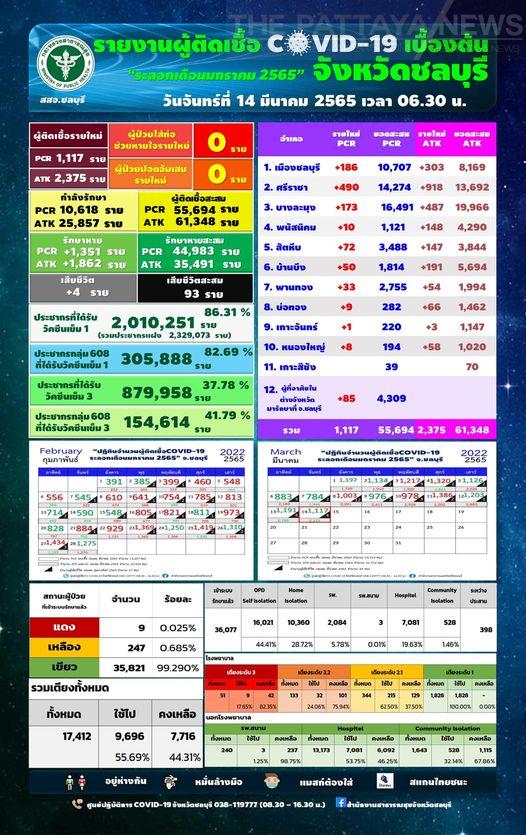Highlights:
1,117 new confirmed cases of Covid-19 in Chonburi today
- 2,375 positive ATK (rapid antigen) tests were reported but all require a second confirmed PCR test before being counted as official cases. The ATK positive tests are just "possible" cases until confirmed by PCR. TPN notes, however, that second confirmed tests are no longer mandatory except for high-risk groups.
1,351 (PCR) and 1,862 (ATK) recovered and were released from medical care
Four new deaths
The Chonburi Department of Public Health announced 1,117 new and confirmed cases of Covid-19 today with four new deaths, March 14th, 2022.
This makes a total of 55,694 cases (PCR) and 61,348 cases (ATK) of Covid-19 in the current round of infections, with 10,618 (PCR) and 25,857 (ATK) people still under medical care/supervision, and with a total of 93 recorded deaths in Chonburi since the start of this recent round of infections at the beginning of this year, January 2022.
Additionally, 1,351 (PCR) and 1,862 (ATK) people were also released and recovered yesterday in Chonburi. 44,983 (PCR) and 35,491 (ATK) people in total have now been released from medical care and recovered in Chonburi since this current wave of Covid-19 began at the beginning of this year, January 2022.
The four new deaths were at the age of 49, 68, 80 and 86 with personal health problems and pre-existing conditions. ฺOne of them was not vaccinated.
In total, 2,010,251 people in Pattaya and Chonburi have received their first dose of a Covid -19 vaccine which is 86.31 percent of the total Chonburi population. Of those, 305,888 have received their first dose and are what the Thai government calls 608 groups (elders, have chronic health problems, and pregnant) which is 82.69 percent of those in these risk groups in Chonburi.
879,958 people have received their triple dose which is 37.78 percent of the total Chonburi population. Of those, 154,614 are 608 groups which is 41.79 percent of those in these risk groups in Chonburi.
The district-level new cases were as follows today:
Mueang Chonburi 186, Si Racha 490, Banglamung (Pattaya) 173, Panat Nikhom 10, Sattahip 72, Ban Bueng 50, Phan Thong 33, ฺBor Thong 9, Ko Chan 1, Nong Yai 8, and 85 people transferred from other provinces for medical care.

The details on the cases are as follows:
- Work and stayed in Rayong, transferred from other provinces for medical care, 64 cases
- Cluster, First Material Science company in Si Racha, 3 cases
- Risky occupations meeting many people, 46 cases
- 21 medical personnel
- 7 back from other provinces from Bangkok (3), Sisaket (2), Chachoengsao (1), and Samut Prakan (1)
- Close contacts from previously confirmed cases in families – 261 cases, in workplaces –61 cases, close personal contacts – 59 cases, and joined a party – 3 cases
- Close contacts of a confirmed patient (under investigation), 37 cases
- 555 cases close contacts of a confirmed patient (under investigation)]
